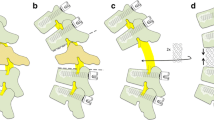Abstract
Purpose
The study aimed to investigate the clinical outcomes and limitations after vertebroplasty with posterior spinal fusion (VP+PSF) without neural decompression for osteoporotic vertebral collapse.
Methods
We conducted a prospective multicenter study including 45 patients (12 men and 33 women, mean age: 77.0 years) evaluated between 2008 and 2012. Operation time, blood loss, visual analog scale (VAS) of back pain, neurological status, kyphosis angle in the fused area, and vertebral union of the collapsed vertebra were evaluated.
Results
The mean operation time was 162 min and blood loss was 381 mL. The postoperative VAS score significantly improved, and the neurological status improved in 35 patients (83 %), and none of the remaining patients demonstrated a deteriorating neurological status at two years post-operatively. The mean kyphosis angle pre-operatively, immediately post-operatively, and two years post-operatively was 23.8°, 10.7°, and 24.3°, respectively, and there was no significant difference between the angles pre-operatively and two years post-operatively. The extensive correction of kyphosis >16° was a risk factor for a higher correction loss and subsequent fracture. Union of the collapsed vertebra was observed in 43 patients (95 %) at two years post-operatively.
Conclusions
The present study suggests that spinal stabilization rather than neural decompression is essential to treat OVC. Short-segment VP+PSF can achieve a high union rate of collapsed vertebra and provide a significant improvement in back pain or neurological status with less invasive surgery, but has a limit of kyphosis correction more than 16°.



Similar content being viewed by others
References
Frost HM (1981) Clinical management of the symptomatic osteoporotic patient. Orthop Clin North Am 12:671–681
Lee YL, Yip KM (1996) The osteoporotic spine. Clin Orthop Relat Res 323:91–97
Sudo H, Ito M, Abumi K et al (2010) One-stage posterior instrumentation surgery for the treatment of osteoporotic vertebral collapse with neurological deficits. Eur Spine J 19:907–915
Uchida K, Nakajima H, Yayama T et al (2010) Vertebroplasty-augmented short-segment posterior fixation of osteoporotic vertebral collapse with neurological deficit in the thoracolumbar spine: comparisons with posterior surgery without vertebroplasty and anterior surgery. J Neurosurg Spine 13:612–621
Baba H, Maezawa Y, Kamitani K et al (1995) Osteoporotic vertebral collapse with late neurological complications. Paraplegia 33:281–289
Kaneda K, Asano S, Hashimoto T et al (1992) The treatment of osteoporotic-posttraumatic vertebral collapse using the Kaneda device and a bioactive ceramic vertebral prosthesis. Spine 17:S295–S303
Taneichi H, Kaneda K, Oguma T et al (2000) Risk factor analysis for osteoporotic vertebral collapse and pseudoarthrosis (in Japanese). Rinsyo Seikeigeka 37:437–442
Kashii M, Yamazaki R, Yamashita T et al (2013) Surgical treatment for osteoporotic vertebral collapse with neurological deficits: retrospective comparative study of three procedures—anterior surgery versus posterior spinal shorting osteotomy versus posterior spinal fusion using vertebroplasty. Eur Spine J 22:1633–1642
McDonnell MF, Glassman SD, Dimar JR 2nd et al (1996) Perioperative complications of anterior procedures in the spine. J Bone Joint Surg Am 78:839–847
Okuda S, Oda T, Yamasaki R et al (2012) Surgical outcomes of osteoporotic vertebral collapse: a retrospective study of anterior spinal fusion and pedicle subtraction osteotomy. Global Spine J 2:221–226
Oda I, Fujiya M, Hasegawa K et al (2008) Surgical treatment for pseudoarthrosis of osteoporotic vertebral fractures-posterior decompression and vertebroplasty with instrumentation. J Jpn Spine Res Soc 19:646–658
Ataka H, Tanno T, Yamazaki M (2009) Posterior instrumented fusion without neural decompression for incomplete neurological deficits following vertebral collapse in the osteoporotic thoracolumbar spine. Eur Spine J 18:69–76
Fukui M, Chiba K, Kawakami M et al (2007) JOA back pain evaluation questionnaire: initial report. Clinical Outcomes Committee of the Japanese Orthopaedic Association, Subcommittee on Evaluation of Back Pain and Cervical Myelopathy; Subcommittee on Low Back Pain and Cervical Myelopathy Evaluation of the Clinical Outcome Committee of the Japanese Orthopaedic Association. J Orthop Sci 12:443–450
Bradford DS, McBride GG (1987) Surgical management of thoracolumbar spine fractures with incomplete neurologic deficits. Clin Orthop Relat Res 218:201–216
Sudo H, Ito M, Kaneda K et al (2013) Anterior decompression and strut graft versus posterior decompression and pedicle screw fixation with vertebroplasty for osteoporotic thoracolumbar vertebral collapse with neurologic deficits. Spine J 13:1726–1732
Chang KW, Chen YY, Lin CC et al (2005) Apical lordosating osteotomy and minimal segment fixation for the treatment of thoracic or thoracolumbar osteoporotic kyphosis. Spine 30:1674–1681
Suk SI, Kim JH, Lee JH et al (2003) Anterior-posterior surgery versus posterior closing wedge osteotomy in posttraumatic kyphosis with neurologic compromised osteoporotic fracture. Spine 28:2170–2175
Author information
Authors and Affiliations
Corresponding author
Ethics declarations
Conflict of interest
The authors report no conflict of interest concerning the materials or methods used in this study or the findings specified in this paper.
Funding
None.
Rights and permissions
About this article
Cite this article
Katsumi, K., Hirano, T., Watanabe, K. et al. Surgical treatment for osteoporotic thoracolumbar vertebral collapse using vertebroplasty with posterior spinal fusion: a prospective multicenter study. International Orthopaedics (SICOT) 40, 2309–2315 (2016). https://doi.org/10.1007/s00264-016-3222-3
Received:
Accepted:
Published:
Issue Date:
DOI: https://doi.org/10.1007/s00264-016-3222-3




